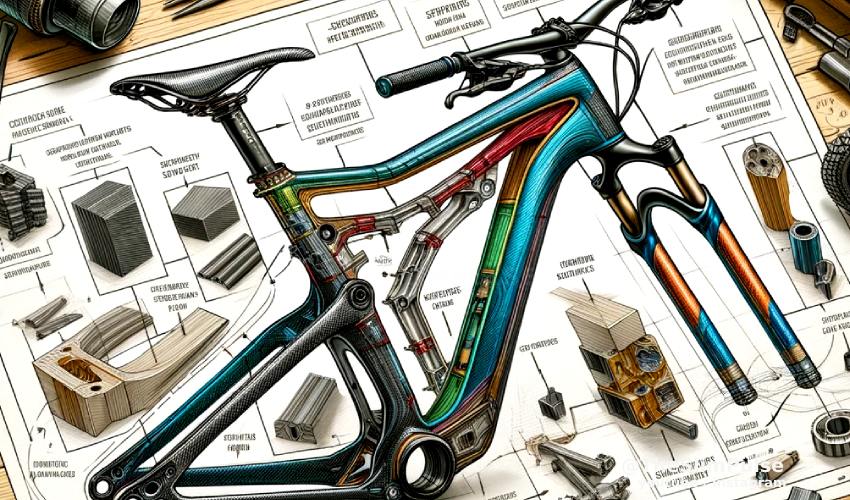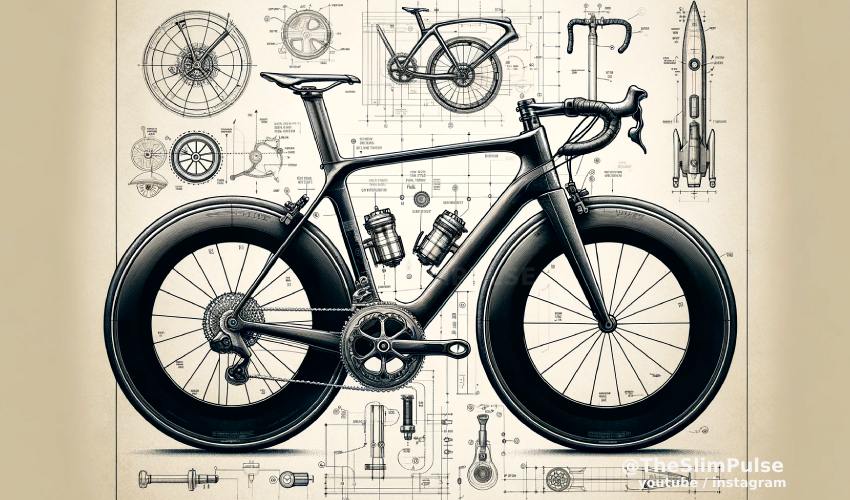Quick search
When it comes to electric bikes (e-bikes), the conversation often revolves around battery life, motor power, and the latest technical features. However, there’s a fundamental aspect that significantly impacts the quality of your ride but often flies under the radar: frame stiffness.
The material from which your e-bike frame is made – whether it’s carbon, steel, aluminum, or titanium – plays a crucial role in how your bike behaves, feels, and performs on the road or trail. Let’s delve into the world of frame materials and stiffness, and see how it affects your e-bike experience.
Understanding Frame Stiffness
Frame stiffness refers to how much a bike frame bends under load. This property is crucial because it affects the handling, efficiency, and comfort of the bike. A frame that is too stiff can transmit more road vibrations to the rider, leading to a harsher ride. Conversely, a frame that is too flexible may feel less responsive, especially when pedaling hard or cornering. There’s a “Goldilocks zone” of stiffness that balances responsiveness with comfort, and finding it can significantly enhance your ride.
The Impact of Frame Materials on Stiffness
Each frame material offers a unique blend of stiffness, weight, durability, and ride comfort. Here’s how the four primary materials stack up:
Carbon Frame
Known for its high stiffness-to-weight ratio, carbon fiber allows for precise control over frame stiffness. Engineers can design carbon fiber frames that are stiff where needed (such as the bottom bracket for efficient power transfer) and compliant where desired (such as the seat stays for comfort). This material offers a customized riding experience but comes at a premium price.
Steel Frame
Celebrated for its durability and natural flex, steel frames provide a comfortable, “springy” ride that many cyclists love. Although generally heavier than other materials, the flexibility of steel makes it an excellent choice for long rides and rough roads. It’s also the most repairable material, contributing to longevity.
Aluminum Frame
Aluminum frames are known for their stiffness, translating to efficient power transfer and snappy handling. However, this stiffness can also result in a less forgiving ride over bumps and potholes. Advances in aluminum frame design, including butted tubes and hydroforming, have helped improve ride comfort while keeping costs lower than carbon fiber.
Titanium
Titanium frames strike a balance between the lightweight, stiffness of carbon fiber and the comfort of steel. They are incredibly durable and resistant to corrosion, making them a lifelong investment for many riders. The natural flex patterns of titanium provide a smooth ride, although like carbon fiber, it comes at a higher cost.

Frame Stiffness in Action: E-Bike Considerations
E-bikes introduce additional factors into the frame stiffness equation. The added weight of the motor and battery, along with increased power output, requires a frame that can handle extra forces without compromising the rider’s handling or comfort.
Furthermore, a well-designed e-bike frame can help optimize battery efficiency by ensuring that energy is not wasted through excessive frame flex.
For fast commuting or road riding, you may appreciate the efficiency of a stiffer carbon or aluminum frame. If you’re exploring off-road trails or embarking on long rides, the comfort of steel or titanium may be more your speed.
Choosing the Right Frame Material
Selecting an e-bike is not just about the specs; it’s about how the bike feels when you ride it. Here are a few tips for finding your ideal frame material:
- Test Ride: There’s no replacement for experiencing how a bike rides. Pay attention to how it handles bumps and accelerations. Does it feel too harsh, or does it absorb the road in a way that feels natural to you?
- Consider Your Riding Style: Are you seeking speed and efficiency, or is comfort over long distances more your priority? Your riding style and preferences should guide your material choice.
- Think Long Term: Frame material not only affects ride comfort but also durability and maintenance. Consider how much time and money you’re willing to invest in your e-bike over the years.
Considerations About Bike Types
When choosing the frame material and assessing stiffness for these specialized e-bikes, consider the following:
- Riding Conditions: Consider where you’ll be riding. High-speed pedelecs benefit from stiffer frames for stability at speed, while cargo bikes require stiffness for load management but also some compliance for comfort.
- Load and Usage: Evaluate how much weight the bike will regularly need to carry. Cargo bikes require a frame that can handle significant loads without compromising handling or safety.
- Portability and Storage: For electric folding bikes, consider the ease of folding and the compactness of the folded bike. The frame material and design should facilitate easy handling and storage without sacrificing ride comfort.
- Personal Preferences: Ultimately, the choice of frame material and desired level of stiffness will also come down to personal preferences in ride feel, handling, and comfort.
Which Frame Material per Bike Type
Indeed, the preferred material and level of stiffness can vary significantly depending on the type of bike and intended use. Here’s a breakdown of common bike types and the materials or stiffness characteristics typically favored for each:
1. Electric City Bikes (E-Bikes)
Aluminum is common in e-bikes due to the balance of weight, cost, and strength. Carbon fiber is used in premium models to reduce weight and refine ride characteristics. Steel and titanium are found in specialized or custom e-bike frames.
E-bikes generally require stiffer frames to support the extra weight of the motor and battery system and to handle the increased forces of electric-assisted speeds.
2. Electric Folding Bikes: Compactness and Flexibility
Aluminum is the most common material for electric folding bikes due to its lightweight properties and the need for the bike to be easily portable. The strength of the material also supports the unique structural requirements of folding mechanisms without significantly increasing the weight of the bike.
Aluminum:
Dominates the folding e-bike market due to its blend of stiffness, lightweight, and affordability. Aluminum frames can be designed to provide sufficient stiffness for a solid ride while still accommodating the necessary folding points without significant weight penalties.
Steel:
Although heavier, the natural resilience of steel makes it an excellent candidate for folding bikes, providing durability at hinge points and a smoother ride. Its ability to absorb vibrations can be a boon on the varied surfaces that folding bikes often encounter.
Titanium:
Extremely expensive to use and therefore often not chosen in bike design is titanium. It offers tremendous benefits but also makes the bike (unnecessarily) expensive. We see this rarely. Folding bikes that do utilize titanium are typically the lightest folding bikes.
Moderate stiffness is preferred for electric folding bikes. The frame needs to be stiff enough to handle the power output of the electric motor and provide a stable ride when unfolded. However, excessive stiffness is not necessary due to the lower average speeds and urban environments where these bikes are typically used. Comfort is also a consideration as riders may use these bikes for commuting on varied city surfaces.
Electric folding bikes pose unique challenges due to their hinges and the need to incorporate a battery into a compact frame.

3. Electric Cargo Bikes: Stability and Load Management
Steel is a favorite material for electric cargo bikes due to its high strength and durability, which are essential for carrying heavy loads. Aluminum is also used for its lighter weight, helping to offset the additional weight of the load and electric assist system.
Cargo Bikes with Steel Frame
With its superior strength and natural flex, steel is a popular choice for cargo bikes. It provides the durability needed to withstand the rigors of heavy loads and compliance to ensure a comfortable ride for both the rider and passengers or cargo.
Cargo Bikes with Aluminum Frame
For those seeking a lighter alternative, aluminum can provide the necessary stiffness for efficient load management, although it may result in a firmer ride. Aluminum cargo bikes often feature design elements such as thicker tubes or reinforced joints to enhance load capacity and stability.
High frame stiffness is crucial for electric cargo bikes to ensure stability and safety when carrying loads. The frame must withstand bending under load to maintain handling predictability and protect the integrity of the bike’s structure, especially when carrying uneven loads or navigating urban environments. The design often includes reinforced tubes and optimized geometries to effectively distribute weight.
An overview of the best cargo bikes. Although the choice is different if you want a tricycle or one specifically for dogs.
Cargo bikes, including longtail models and box bikes, are designed for carrying heavy loads, from groceries to children. Frame stiffness becomes of paramount importance in maintaining stability and control, especially with a low center of gravity and extensive rear or front cargo areas.
4. Speed Pedelecs: The Need for Speed and Stiffness
Carbon fiber and aluminum are the preferred materials for high-speed electric bicycles. Carbon fiber offers the advantage of lightweight and stiffness, which is beneficial for efficiency and handling at higher speeds. It also enables fine-tuning of compliance areas to enhance rider comfort. Aluminum provides a cost-effective alternative with good stiffness-to-weight ratios, suitable for the demands of high-speed cycling.
Carbon Speed Pedelecs:
Ideal for those seeking the ultimate in speed and efficiency. The high stiffness-to-weight ratio contributes to a responsive and agile ride, crucial for navigating at higher speeds. Carbon fiber’s ability to be formed into aerodynamic shapes also provides an advantage in reducing air resistance.
An example is the Specter 1 speed pedelec.
Aluminum Speed Pedelecs:
Offers a cost-effective alternative to carbon, providing the necessary stiffness for efficient power transfer and confident handling at speed. Advances in aluminum technology, including tube shaping and alloy composition, have improved ride comfort, making it a solid choice for speed enthusiasts.
An example is the Ellio Max speed pedelec.
Very high stiffness is essential for high-speed electric bicycles to ensure precise handling and stability at speeds up to 45 km/h. The frame must efficiently transfer the power from both the rider and the electric motor without flexing, which could compromise control and safety. At the same time, strategic compliance is incorporated into the frame design to manage road vibrations and improve comfort during longer rides at high speeds.
The best speed pedelecs, capable of reaching speeds up to 45 km/h, require a frame that can handle high speeds with unwavering stability. The increased speed intensifies the forces acting on the bike, making frame stiffness a crucial factor for both safety and performance.
5. E-Road Bikes
Carbon fiber is highly popular for high-end road bikes due to its lightweight and the ability to be designed for specific stiffness and compliance areas. Aluminum is a common choice for entry to mid-range road bikes, offering a good balance between stiffness and cost-effectiveness.
High stiffness in the bottom bracket and head tube areas is preferred for efficient power transfer and precise handling. However, some compliance (flexibility) in the seatstays and fork can enhance comfort over long distances.
An overview of the best road bikes.
6. E-Mountain Bikes
Aluminum is widely used for mountain bike frames due to its durability and cost-effectiveness. Carbon fiber is favored in high-end models for its lighter weight and tunable stiffness. Steel is chosen for some niche, hardcore hardtail frames for its toughness and ride feel.
A moderate to high level of frame stiffness is desirable for handling rough terrain and ensuring the bike responds predictably. However, too much stiffness can make the ride overly harsh, so manufacturers often design frames with strategic flex zones to absorb shocks.
An overview of the best mountain bikes.
7. E-Gravel Bikes
Carbon fiber and aluminum are common choices, with carbon providing comfort through vibration damping and aluminum offering a more affordable option. Steel and titanium are also favored for their natural compliance and durability, making them excellent choices for adventurous riding.
Gravel bikes benefit from a balance of stiffness for efficient pedaling and compliance for comfort on uneven surfaces. Frame designs often focus on absorbing vibrations and shocks without sacrificing power transfer.
For each of these specialized e-bike categories, manufacturers carefully consider the balance of material properties, frame stiffness, and the specific demands of the bike’s intended use. This ensures that the end product not only meets riders’ performance expectations but also provides the necessary comfort, safety, and durability for its specialized application.

